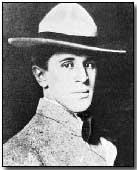Primary Documents - U.S. Government Press Bureau's Statement on the Role of U.S. Naval Destroyers, June 1917
 Reproduced below is the
text of the official press announcement issued by
George Creel, head of the
U.S. Government's Press Bureau, in June 1917. Creel's press release,
somewhat sensational in tone - in contrast to similar bulletins issued by
either his British or French counterparts - recounted how U.S. destroyers
were attacked by German U-boats during their first sailing to Europe
accompanying troops transport ships in June 1917.
Reproduced below is the
text of the official press announcement issued by
George Creel, head of the
U.S. Government's Press Bureau, in June 1917. Creel's press release,
somewhat sensational in tone - in contrast to similar bulletins issued by
either his British or French counterparts - recounted how U.S. destroyers
were attacked by German U-boats during their first sailing to Europe
accompanying troops transport ships in June 1917.
The veracity of the press release was called into question at the time; in reaction to the controversy the tone of subsequent press releases was toned down.
Click here to read Josephus Daniels' official report detailing the role of the U.S. Navy during wartime; click here to read Charles C. Gill's report outlining the role of the transport service.
Official Announcement by the U.S. Government Press Bureau Regarding Destroyers by George Creel, June 1917
Accompanying the first U. S. Transport Fleet to France German submarines attacked the transports in force. They were outfought by the American escorting destroyers, and at least one submarine was destroyed.
No American ship was hit, and not a life lost. The German submarines attacked twice. On both occasions the U-boats were beaten off with every appearance of loss. One boat was certainly sunk, and there is reason to believe that the accurate fire of our gunners sent others to the bottom.
For the purposes of convenience the expedition was divided into contingents. Each contingent was composed of troopships and a naval escort designed to keep off such German raiders as might be met with. An ocean rendezvous was arranged with the American destroyers now operating in European waters in order that the passage through the danger zone might be attended by every possible protection.
The first attack occurred at 10.30 p.m. on June 22nd. What gives it a peculiar and disturbing significance is that our ships were set upon at a point well on this side of the rendezvous, in a part of the Atlantic which might have been presumed free from submarines.
The attack was made in force, and although the night made it impossible to arrive at an exact count, it was clear that the U-boats had gathered for what they deemed would be a slaughter. The heavy gunfire of the American destroyers scattered the submarines. It is not known how many torpedoes were launched, but at least five were counted.
The second attack was launched a few days later against another contingent, the point of attack being beyond the rendezvous. Not only did the destroyers hold the U-boats at a safe distance, but their speed resulted in the sinking of at least one submarine. Grenades were used, firing a charge of explosives timed to go off at a certain distance under water.
In one instance the wreckage covered the surface of the sea after a shot at a periscope, and reports claim that the boat was sunk.
Protected by our high-seas convoy, destroyers, and by French war vessels, the contingent proceeded and joined the others at the French port. The whole nation will rejoice that so great a peril was passed by the vanguard of the men who will fight our battles in France.
Source: Source Records of the Great War, Vol. V, ed. Charles F. Horne, National Alumni 1923
The Russian war ace Alexander Kozakov claimed 20 victories during the war; his nearest compatriot, Vasili Yanchenko, claimed 16.
- Did you know?
